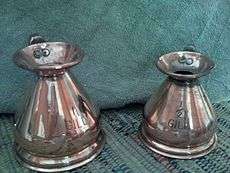Gill (unit)
| Look up gill in Wiktionary, the free dictionary. |

The gill (pronounced[1] /ˈdʒɪl/ (![]()
- In imperial units
1 imperial gill ≡ 5 imperial fluid ounces ≡ 1⁄32 imperial gallon ≡ 1⁄4 imperial pint ≡ 142.0653125 ml[3] ≈ 142 ml ≈ 1.2 US gills
- In United States customary units
1 US gill ≡ 4 US fl oz ≡ 1⁄32 US gallon ≡ 1⁄4 US pint ≡ 1⁄2 US cup ≡ 8 tablespoons ≡ 24 teaspoons ≡ 32 US fluid drams ≡ 77⁄32 in3 ≡ 118.29411825 ml[4] ≈ 118 ml ≈ 5⁄6 imperial gills
In Great Britain, the standard single measure of spirits in a pub was 1⁄6 gill (23.7 ml) in England, and 1⁄5 gill (28.4 ml) in Scotland. The 1⁄4 gill (35.5 ml) was previously the most common measure in Scotland, and still remains as the standard measure in pubs in Ireland. After metrication this was replaced by either 25 ml (0.176-gill) or 35 ml (0.246-gill) measures (landlords can choose which one to serve).
Half of a gill is a jack, so an eighth of a pint.[5] But in northern England, a quarter pint could also be called a jack or a noggin rather than a gill, and in some areas a half pint could be called a gill, particularly for beer and milk.[6][7][8]
In Ireland, the standard spirit measure was historically 1⁄4 gill. In the Republic of Ireland, it still retains this value, though it is now legally specified in metric units as 35.5 ml.
In Scotland, there were additional sizes:[9]
- big gill = 1.5 Imp. gill
- wee gill = 3/4 Imp. gill
- wee half gill = 3/8 Imp. gill
- nip=1/4 Imp. gill
In popular culture
There are occasional references to a gill in popular culture, such as in:
Literature
- In L. Frank Baum's The Patchwork Girl of Oz, one of the ingredients required for a magic spell is a gill of water from a dark well. In chapter 19, the obscure unit is used for humor including a pun with the nursery rhyme "Jack and Jill", which also involved a well.
- In George Orwell's Animal Farm, Moses the Raven is allotted a gill of beer a day after he returns, with the implication that this is part of his payment for supporting the farm leaders, the pigs.
- Dan Simmons' novel, The Terror (2007), makes frequent references to gills of grog and rum.
- In Robert Louis Stevenson's Treasure Island there are uses of the measure gill, with Israel Hands drinking a gill of brandy in the chapter 'I Strike the Jolly Roger'.
Music
- The cumulative song "The Barley Mow".[10]
- In The Doors song "The Crystal Ship", the line, "the crystal ship is being filled a thousand girls," some people report that "girls" should be "gills".
Television
- A gill is also referenced in Archer season 2, episode 3 ("Blood Test") when Barry explains to Archer that a liter is, "about 8 gills". (Eight gills would be 40 Imperial fluid ounces, or 1.13 Liters).
- In "Bart the Genius," an episode of The Simpsons, a child tricks Bart by offering, "I'll trade you 1,000 picoliters of my milk for four gills of yours." (A picoliter is a trillionth of a liter, so Bart is losing almost a pint of milk in this exchange.)
Mispronunciation
Because of its more widely used homograph, gill is often mispronounced with a hard 'g' sound.
- FX's animated cartoon Archer, mispronounced gill in the episodes "Blood Test" (Season 2, Episode 3)[11] and "Heart of Archness: Part Three" (Season 3, Episode 3).[12]
- Television host Stephen Fry mispronounced gill in a 2013 edition of the BBC TV programme QI.
Notes
- ↑ Not /ˈɡɪl/ (

- ↑ This was the legal definition although in some areas a gill of milk or beer is referred to as a half-pint; elsewhere a gill was the 1⁄3 pint of milk given free to school children.
- ↑ after 1985 in the UK, c. 1964 in Canada
- ↑ after 1964 redefinition of litre and 1959 redefinition of inch
- ↑ Klein, Herbert Arthur (1974). The Science of Measurement: A Historical Survey. New York: Dover Publications, Inc. p. 34. ISBN 0-486-25839-4. Retrieved 30 October 2016.
- ↑ Griffiths, Samuel (1873). Griffiths' Guide to the Iron Trade of Great Britain. p. 292.
- ↑ O'Gorman, Daniel (1853). Intuitive calculations; the readiest and most concise methods. Manchester. p. 50.
- ↑ International Dictionary of Food and Cooking by Charles Gordon Sinclair, ISBN 1-57958-057-2, published by Taylor & Francis, 1998
- ↑ "The Scottish Licensing Laws". Retrieved 6 September 2016.
- ↑ "Good Luck to the Barley Mow, lyrics and audio". Chivalry.com. Retrieved 2011-02-14.
- ↑ VanDerWerff, Todd. "Archer: "Blood Test"".
- ↑ VanDerWerff, Todd. "Archer: "Heart Of Archness, Part Three"".